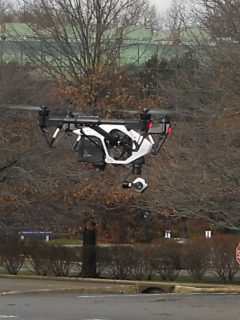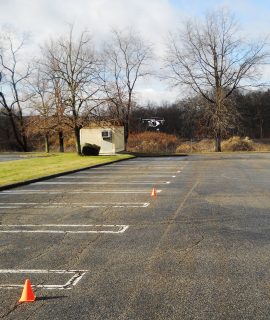STORY AND PHOTOS BY JANIE ROSMAN
The new drone culture comes with rules.
 Safety rule number one is to stay behind whoever is flying the drone, never in front of the person. “If you get uncomfortable and are not sure what to do, let go, and it will hover in place,” Boston-based DARTdrones Flight Academy instructor Chris Bailey told participants in his class last Saturday.
Safety rule number one is to stay behind whoever is flying the drone, never in front of the person. “If you get uncomfortable and are not sure what to do, let go, and it will hover in place,” Boston-based DARTdrones Flight Academy instructor Chris Bailey told participants in his class last Saturday.
A former helicopter pilot for the U.S. Navy, and an aviation safety officer with the U.S. Army National Guard with more than 20 years’ experience, Bailey said he never knows who will attend his classes.
“We get law enforcement, fire and rescue personnel, and the general civilian population,” Bailey explained. “Fire personnel use drones to evaluate hot spots in a building, and law enforcement use them to take pictures of accident scenes, skid marks.”
A large percentage of these remote-controlled flying aircraft that date back to the 1930s are hobbyists, Bailey said. “The training we provide gets people ready to fly them…not so much fly as manage them.”
Past students included the mayor of a small town, a real estate agent visiting from Bolivia seeking information that he could bring to his government, and Rockland County Sheriff’s Detective Schlomo Koenig.
 Participants in Saturday’s daylong DARTdrones’ three-part course — Drone 101 was an introduction to the industry, and DJI Basic and DJI Advanced were specific to drone operations — at the Crowne Plaza Suffern Mahwah used the machines for both commercial and personal use.
Participants in Saturday’s daylong DARTdrones’ three-part course — Drone 101 was an introduction to the industry, and DJI Basic and DJI Advanced were specific to drone operations — at the Crowne Plaza Suffern Mahwah used the machines for both commercial and personal use.
“DJI is the largest drone company, which is why we use them in class” and instructions are based on DJI drone, Bailey said.
Frank Ballestero is retired and flies drones to inspect cell towers and take pictures of building facades. “Instead of climbers we use drones,” he said. “Photographs are also taken from inside towers. With this (drone) I can shoot (pictures) from the top, the bottom, the sides and submit it to AT&T, Verizon, T-Mobile. It will be used as a tool.”
Ismael Asima (Izzy) has been flying RC (radio-controlled) drones as a hobby for the past eight years. “I came here to learn more and have learned a few new things I didn’t know before about the interface,” he said.
 Glenn Carman, who belongs to a search and rescue organization, drove to the class from eastern Pennsylvania. “There are times we can’t get our aircraft in for visual searches but we can fly this (points to his drone) up to 400 feet, which allows us to do what the aircraft can do at a much lower altitude,” he said.
Glenn Carman, who belongs to a search and rescue organization, drove to the class from eastern Pennsylvania. “There are times we can’t get our aircraft in for visual searches but we can fly this (points to his drone) up to 400 feet, which allows us to do what the aircraft can do at a much lower altitude,” he said.
All received a certificate that enables them to operate their drones provided they have insurance.
The Federal Aviation Administration considers three types of unmanned aircraft systems (UAS): public operations (governmental), civilian aircraft (non-governmental) and model aircraft (hobby or recreational use).
While each level of user must abide by specific regulations, Bailey said, the one rule all must heed is no flying within five miles of airports, schools, water treatment facilities or power stations or government buildings (prisons or detention centers).
Hobbyists who operate drones for fun must fly them below 500 feet and not over people or at night. Those hired for commercial business — contracting with an engineering firm that inspects buildings and bridges, for example — can fly up to 400 feet, “a discrepancy of height,” Bailey noted. “This person working for a company needs a pilot’s license, and the company hiring needs an FAA 333 exemption.”
 The third category of users is law enforcement or government entities because there’s currently no certification for drone operators.
The third category of users is law enforcement or government entities because there’s currently no certification for drone operators.
“The industry and its lessons are not standardized,” he said. The FAA was to have implemented rules to designate between drone operators and commercial pilots; however, until it does, he said, “you need a pilot’s license to operate a drone commercially.”
Any drone weighing more than half a pound must be registered and then receives a number from the FAA (like civilian airplanes or helicopters). Companies hiring drones need exemptions for the drone to operate commercially. Bailey said the FAA considers his quad copter (has four rotors) an airplane the same way a Boeing 747 is an airplane.
“The average price for a drone is $3,000 to $5,000,” Bailey said, “and their biggest use is for agriculture, and prices can range to $65,000 or $70, 000,” mostly because of high-powered cameras attached to them.
DARTdrones is a female run, military veteran owned, family business that provides the highest quality training on Unmanned Aerial Systems for businesses, emergency service teams, and hobbyists while employing military veterans as the flight captains. For information visit http://dartdrones.com/.

You must be logged in to post a comment Login